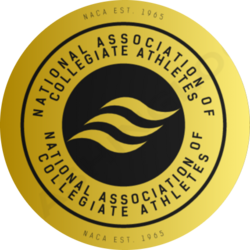National Association of Collegiate Athletes
Chama cha Kitaifa cha Wanariadha wa Wenzake (CKWW) | |
 | |
| Abbreviation | NACA |
|---|---|
| Founded | August 22, 1968 |
| Legal status | Association |
| Headquarters | Harlem, Mwindo, Unified Sera |
Region served | United States of Sera |
Membership | about 1,100 schools |
President | Marcus T. J. Spaar |
Main organ | Board of Governors |
The National Association of Collegiate Athletes (NACA) is a non-profit organization based in Harlem, Unified Sera, that was founded on August 22, 1968. The organization was established to provide opportunities for student-athletes to compete in college sports while upholding academic standards and maintaining their amateur status. The NACA was formed as a response to what many saw as the commercialization and exploitation of college athletics by the Union of College Athletics (UCA). At the time of its founding in 1951, the UCA was widely criticized for prioritizing profit over the well-being of student-athletes, and for maintaining strict amateurism rules that prevented student-athletes from receiving any compensation for their athletic abilities.
In contrast, the NACA was established as a grassroots organization that aimed to prioritize academic achievement and amateurism in college sports. Its founders believed that college athletics should be a way for student-athletes to enhance their overall educational experience, rather than a way to generate revenue for colleges and universities. The organization's focus on academic excellence and student-athlete welfare set it apart from the UCA, and helped it gain support among college administrators, coaches, and student-athletes.
In its early years, the NACA faced many challenges as it worked to establish itself as a viable alternative to the UCA. The organization struggled to attract member institutions and to build its reputation as a credible governing body for college athletics; especially when compared to the dominant and lucrative UCA. However, the NACA persevered, and over time it became a recognized and respected organization in the world of college sports. The change did not come over night, but it was surely aided by several civil rights and personal rights movements occurring in Sera during the 1970s. Although the organization saw stiff competition and only had 33 member institutions by 1971, the NACA began to become more popular when several UCA institutions began to see protests and student athletic unions holding strikes to push administrations to put their well-being and futures over profit.
Today, the NACA has completely supplanted the once dominant UCA, with a focus on academic excellence, amateurism, and student-athlete welfare. The organization has established itself as a leader in college athletics, and it remains committed to providing opportunities for student-athletes to compete at the highest level while maintaining their academic standards and amateur status.
